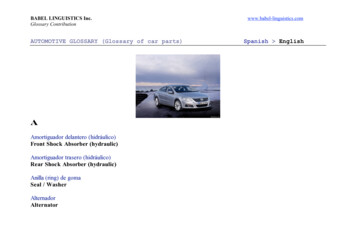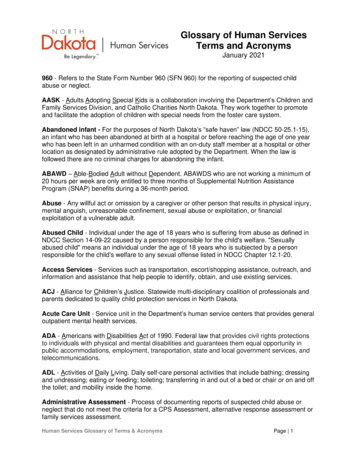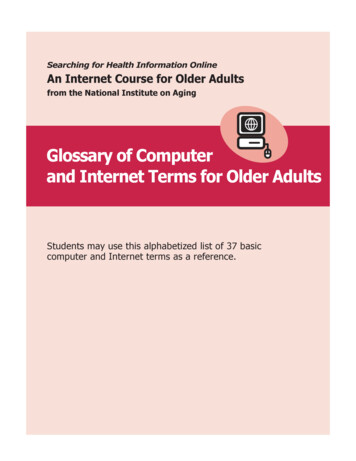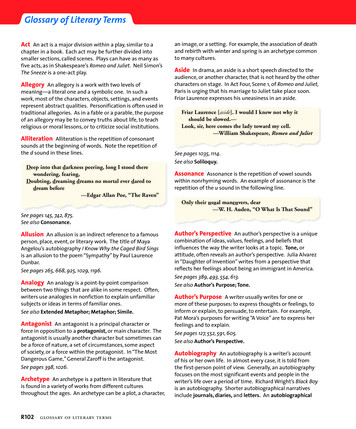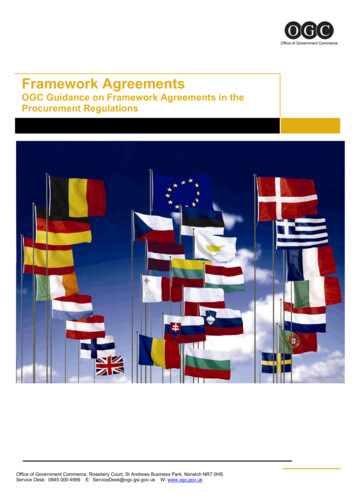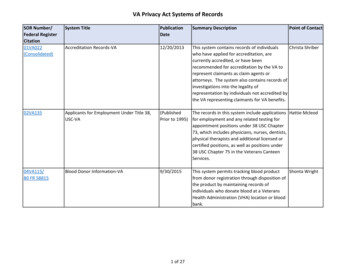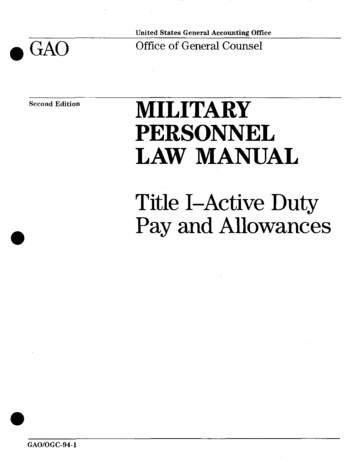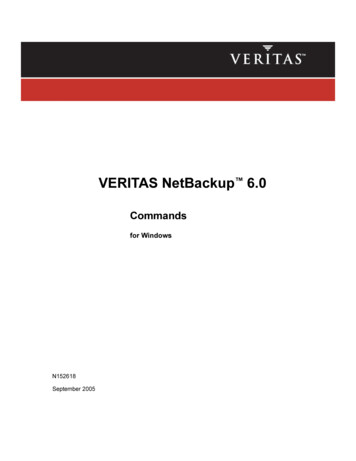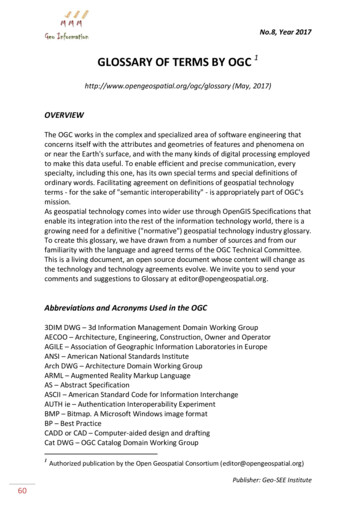
Transcription
No.8, Year 2017GLOSSARY OF TERMS BY OGC 1http://www.opengeospatial.org/ogc/glossary (May, 2017)OVERVIEWThe OGC works in the complex and specialized area of software engineering thatconcerns itself with the attributes and geometries of features and phenomena onor near the Earth's surface, and with the many kinds of digital processing employedto make this data useful. To enable efficient and precise communication, everyspecialty, including this one, has its own special terms and special definitions ofordinary words. Facilitating agreement on definitions of geospatial technologyterms - for the sake of "semantic interoperability" - is appropriately part of OGC'smission.As geospatial technology comes into wider use through OpenGIS Specifications thatenable its integration into the rest of the information technology world, there is agrowing need for a definitive ("normative") geospatial technology industry glossary.To create this glossary, we have drawn from a number of sources and from ourfamiliarity with the language and agreed terms of the OGC Technical Committee.This is a living document, an open source document whose content will change asthe technology and technology agreements evolve. We invite you to send yourcomments and suggestions to Glossary at editor@opengeospatial.org.Abbreviations and Acronyms Used in the OGC3DIM DWG – 3d Information Management Domain Working GroupAECOO – Architecture, Engineering, Construction, Owner and OperatorAGILE – Association of Geographic Information Laboratories in EuropeANSI – American National Standards InstituteArch DWG – Architecture Domain Working GroupARML – Augmented Reality Markup LanguageAS – Abstract SpecificationASCII – American Standard Code for Information InterchangeAUTH ie – Authentication Interoperability ExperimentBMP – Bitmap. A Microsoft Windows image formatBP – Best PracticeCADD or CAD – Computer-aided design and draftingCat DWG – OGC Catalog Domain Working Group1Authorized publication by the Open Geospatial Consortium (editor@opengeospatial.org)Publisher: Geo-SEE Institute60
ISSN: 1857-9000, EISSN: 1857-9019Cat SWG – OGC Catalog Revision Standards Working GroupCEN – Comite Europeen de Normalisation (European Committee forStandardization)CGDI – Canadian Geospatial Data InfrastructureCIPI – A 2002 OGC Interoperability Initiative focused on critical infrastructureprotectionCITE – OGC Compliance and Interoperability Testing Initiative, the OGC'sCompliance Testing Program.CityGML – OGC City Geography Markup Language (CityGML) Encoding StandardCOM – Common Object Model, a Microsoft paradigm to connect componentsCORBA – Common Object Request Broker ArchitectureCRS – Coordinate Reference System. Also CRS Domain Working Group.CS – OGC Catalogue Service Interface StandardCSW – OGC Catalog Service Interface Standard for the WebCT – OGC Coordinate Transformation Encoding StandardCT SWG – OGC Coordinate Transformation Standards Working GroupCTL – Compliance Test LanguageCUAHSI – Consortium of Universities for the Advancement of Hydrologic ScienceD&I DWG – Defense and Intelligence Domain Working GroupDBF – Data Base File, the Dbase file formatDBMS – Data Base Management SystemDCE – Distributed Computing EnvironmentDCP – Distributed Computing PlatformDEM – Digital Elevation ModelDEMTS – Digital and Electronic Maps Transfer Standard (Russia)DGIWG – Digital Geospatial Information Working GroupDGN – DesiGN file, the Microstation drawing formatDIGEST – Digital Geographic Exchange StandardDLG – Digital Line GraphDLM – Digital Landscape ModelDP – Discussion PaperDQ DWG – Data Quality Domain Working GroupDS DWG – Decision Support Domain Working GroupDTM – Digital Terrain ModelDWG – Domain Working GroupDXF – Drawing eXchange Format (AutoCAD exchange format)EA – Enterprise ArchitectureEASIG – Enterprise Architecture Special Interest GroupebRIM – OASIS ebXML (OASIS Electronic Business using eXtensible MarkupLanguage) Registry Information Model. See OGC Catalog ebRIM Application Profile:Earth Observation Products.ebXML RegRep SWG – OGC Standards Working Group developing an an extensionto the OASIS ebXML RegRep standardEC08 Pilot – Empire Challenge 08 Pilot Projecthttp://mmm-gi.geo-see.org61
No.8, Year 2017EDM DWG – Emergency & Disaster Management Domain Working GroupEEA – European Environment AgencyEO – Earth ObservationEO2heaven – Earth Observation and Environmental Modelling for the Mitigation ofHealth RisksEOSDIS – Earth Observing System Data and Information SystemEPSG – European Petroleum Survey GroupEuroSDR European Spatial Data ResearchNetworkESDI – European Spatial Data Information InfrastructureESS DWG - Earth System Science Domain Working GroupEUROGI – European Umbrella Organisation for Geographic InformationFE or FES – OGC Filter Encoding StandardGeoAPI – OGC GeoAPI Interface Standard (a Java application programminginterface)GeoRM DWG – Geospatial Rights Management Domain Working GroupGeoSPARQL SWG – GeoSPARQL Standards Working Group (SPARQL is a recursiveacronym for the W3C's "SPARQL Protocol And RDF Query Language")GEOSS Pilot – Global Earth Observation System of Systems Pilot ProjectGeosync SWG – GeoSynchronization 1.0 Standards Working GroupGeoXACML – OGC Geospatial eXtensible Access Control Markup Language StandardGETIS – Geoprocessing networks in a European Territorial Interoperability StudyGITA – Geospatial Information & Technology AssociationGLS SWG – Geographic Linkage Service 1.0 Standards Working GroupGML – OGC Geography Markup Language Encoding StandardGML in JPEG 2000 – OGC standard that defines how GML is used in JPEG 2000imagesGMLJP2 1.1 SWG – GML in JPEG 2000 Standards Working GroupGO – Geospatial Objects (a retired OGC standard)GPC/GIS – GPC Global Information SolutionsGPS – Global Positioning SystemGRSS – IEEE Geoscience and Remote Sensing SocietyGSDI – Global Spatial Data InfrastructureGSDI Association – Global Spatial Data infrastructure (GSDI) AssociationGServRestSWG – GeoServices REST (REpresentational State Transfer) StandardsWorking GroupHDF – Hierarchical Data FormatHTI – Human Technology InterfaceICS – Information Communities and SemanticsICT – Information and Communications TechnologyIE – Interoperability ExperimentIE3D Portrayal – 3D Portrayal Interoperability ExperimentIEC – ISO IEC JTC 1/SC 24/WG 8 - Computer graphics, image processing andenvironmental presentationIEEE GRSS – IEEE Geoscience and Remote Sensing SocietyPublisher: Geo-SEE Institute62
ISSN: 1857-9000, EISSN: 1857-9019IEEE Technical Committee 9 (Sensor Web)iEMSs – International Modeling & Software Society SecretariatIES – Imagery Exploitation Working Group IETF – Internet Engineering Task ForceIETF – Internet Engineering Task ForceIJIS Institute – Integrated Justice Information Systems (IJIS) InstituteILAF – OGC Iberian and Latin-American ForumIndoorGML – common schema framework for interoperability between indoor andoutdoor navigation applications, being drafted by the OGC IndoorGML StandardsWorking GroupIP – Depending on context, either Intellectual Property or Interoperability ProgramIPR - Intellectual Property RightsIPTeam – Interoperability Program TeamIS – Implementation StandardISO – International Organization for StandardizationISO IEC JTC 1/SC 24/WG 8 – Computer graphics, image processing andenvironmental presentationISO Technical Committee 204 – Intelligent transport systemsISO Technical Committee 211 (ISO TC/211) – Geographic information/GeomaticsISOC – Internet SocietyISPRS – International Society for Photogrammetry and Remote SensingITU – International Telecommunication UnionJAG – Joint Advisory Committee between OGC and ISO TC 211JPEG – Joint Photographics GroupKML – OGC KML Encoding Standard (formerly Keyhole Markup Language)LBS – Location Based ServicesLEAPS DWG - Law Enforcement and Public Safety Domain Working GroupLOS – Location Organizer FolderLS DWG – Location Services Domain Working GroupMCP – OGC Marketing & Communications ProgramMet Ocean DWG – Meteorology & Oceanography Domain Working GroupMISMO – Mortgage Information Standards Maintenance OrganizationMLS DWG - Mobile Location Services Domian Working Group - merger of MassMarket and Location Services DWGsMMI – OGC s Multi-Hazard Mapping Initiative (MMI) Phase I (2001)MPP – OGC s Military Pilot Project (MPP) (2001)NCOIC – Net Centric Operations Infrastructure CommitteeNetCDF – OGC Network Common Data Form (NetCDF) Core Encoding Standardversion 1.0 comprises earlier NetCDF Classic and 64–bit Offset Format standardsfrom UCAR/Unidata.NGO – Non-Governmental OrganizationNIBS – National Institute for Building StandardsNIST – National Institute of Standards and TechnologyNMA – National Mapping AgencyNRE – Natural Resources and Environmenthttp://mmm-gi.geo-see.org63
No.8, Year 2017NSDI – National Spatial Data InfrastructureNTF – Neutral Transfer Format (in UK)O&M – OGC Observations and Measurements Encoding StandardOAB – OGC Architecture BoardOASIS – Organization for the Advancement of Structured Information StandardsOCAP – OGC Outreach and Community Adoption (now OGC Marketing andCommunications)OGC – Open Geospatial ConsortiumOGC Reference Model – a complete set of the OGC's reference modelsOGC–A – OGC Austral–AsiaOGC–E – OGC EuropeOGF – Open Grid ForumOI DemoOLE/COM – Object Linking and Embedding/Common Object Model (Microsoft)OLS – OGC Location ServicesOMA – Open Mobile AllianceOMG – Object Management GroupOO – Object OrientedOpen GeoSMS – OGC standard providing an extended Short Messaging Service(SMS) encoding and interface for communicating location contentOpenLS – OGC Open Location Services Interface StandardOSF – Ordering Services Framework for Earth Observation ProductsORM – OGC Reference ModelOSCRE – Open Standards Consortium for Real EstateOSDM – Office of Spatial Data Management (Australia)OSGEO – Open Source Geospatial FoundationOWS – OGC Web ServicesOWSCommon1.2SWG – OWS Common 1.2 SWGOWScontextSWG – OWS Context SWGOWSC – OGC Web Services CommonP&P – Policies and ProceduresPC – Planning CommitteePNG – Portable Network GraphicPubSub SWG – OGC Standards Working Group defining a standard that clearlydefines a standard way to enable publish/subscribe functionality for OGC WebServicesPUCK – OGC standard defining a protocol for RS232 and Ethernet connectedinstrumentsRCM – Risk and Crisis ManagementRESTful – REpresentational State Transfer programming styleRFC – Request for CommentRFI – Request for InformationRFP – Request for Proposals (or Participation)RFT – Request for TechnologyPublisher: Geo-SEE Institute64
ISSN: 1857-9000, EISSN: 1857-9019RM-ODP – Reference Model for Open Distributed ProcessingRPC – Remote Procedure CallRTD – Research and Technology Development (Europe)SAA Pilot – Special Activity Airspace PilotSANY – Sensors Anywhere ConsortiumSCOTS – Standards based Commercial Off-The-Shelf softwareSDI – Spatial Data InfrastructureSDTS – Spatial Data Transfer StandardSE – Symbology EncodingSensorML – OGC Sensor Model Language Encoding StandardSF – Simple FeaturesSF CORBA – Simple Features CORBASF OLE/COM – Simple Features OLE/COMSFS – OGC Simple Features – SQL Encoding StandardSIF – Standard Interchange FormatSIG – Special Interest GroupSLD – OGC SLDSE SWG – Styled Layer Descriptor and Symbology Encoding 1.2Standards Working GroupSLD – Styled Layer DescriptorSMAC – OGC Strategic Member Advisory CommitteeSME – Small or Medium Sized EnterpriseSOA – Services Oriented ArchitectureSOAP – Simple Object Access ProtocolSOS – OGC Sensor Observation Service Interface StandardSP – Standards ProgramSPS – OGC Sensor Planning Service Interface StandardSQL – Structured Query LanguageSLD – Styled Layer Descriptor Encoding StandardTIFF – Tagged Image File FormatSVG – Styled Vector GraphicsSWE – OGC Sensor Web Enablement activitySWE Common – Sensor Web Enablement Common Data ModelSWG – Standards Working GroupTC – Technical CommitteeTC P&P – Technical Committee Policies and ProceduresTDWG – Taxonomic Data Working GroupTEAM Engine – Test, Evaluation, And Measurement EngineTIGER – Topologically Integrated Geographic Encoding and Reference file (US)TJS – OGC Georeferenced Table Joining Service Encoding StandardTML – OGC Transducer Markup Language Encoding Standard (retired)UCAR – University Corporation for Atmospheric Research / National Center forAtmospheric Research (NCAR)UDDI – Universal Description, Discovery, and IntegrationUML – Unified Modeling Languagehttp://mmm-gi.geo-see.org65
No.8, Year 2017Univ DWG – University Domain Working GroupVPF – Vector Product Format (US)USGIF – US Geospatial Intelligence FoundationVR – Virtual RealityW3C – World Wide Web ConsortiumWaterML 2.0 – OGC Water Markup Language Encoding StandardWCPS – OGC Web Coverage Processing Service Interface StandardWCS – OGC Web Coverage Service Interface StandardWCTS – OGC Web Coordinate Transformation Service Interface StandardWeb3D ConsortiumWfMC – Workflow Management CoalitionWFS – OGC Web Feature Service Interface StandardWG – Working GroupWMC – OGC Web Map Context Encoding StandardWMO – World Meteorological OrganizationWMS – OGC Web Map Service Interface StandardWMT – Web Mapping TestbedWMTS – OGC Web Map Tile Service Interface StandardWPS – OGC Web Processing Service Interface StandardWS – Web ServicesWSC – OGC Web Service Common Interface StandardWSDL – Web Services Definition LanguageXIMA – XML for Imagery and Map AnnotationsXML – eXtensible Markup LanguageXSLT – eXtensible Style Sheet TransformationGlossary of Terms - AAbstract Data TypeThe basic information construct used by the GeoMobility Server and associatedCore Services. Consists of well-known data types and structures for locationinformation. Defined as application schemas that are encoded in XML for LocationServices (XLS).accuracySource: OpenGIS GuideThe degree to which information on a map or in a digital database matches true oraccepted values. Accuracy pertains to the quality of data and the number of errorscontained in a dataset or map. In discussing a GIS database, it is possible toconsider horizontal and vertical accuracy with respect to geographic position, aswell as attribute, conceptual, and logical accuracy. The effect of inaccuracy anderror on a GIS solution is the subject of sensitivity analysis. Accuracy, or error, isdistinguished from precision, which concerns the level of measurement or detail ofdata in a database.Publisher: Geo-SEE Institute66
ISSN: 1857-9000, EISSN: 1857-9019agentSource: OpenGIS GuideA kind of intermediary service which acts on behalf of another service (serviceprovider or requester) according to rules established upon its invocation. Alsoknown as an intelligent agent. Annual Technical Baseline TargetThe Annual Technical Baseline Target is the subset of the elements of the TechnicalPlan that are scheduled to be completed within any given calendar year.ANSIAn abbreviation for American National Standards Institute. ANSI standards havebeen established for many elements of computer systems to aid research anddevelopment. The existence of standards allows designers to develop generalsolutions to common problems.appletA small application, with limited functionality, designed to operate in acomponentware and/or middleware environment. Large, multifunctional, monolithic applications can be, and in the future often will be, broken into singlefunction applets that interoperate with other applets, and that can be assembled,perhaps only temporarily, into a user s work environment. Java applets, forexample, are typically downloaded via the Internet into your computer s programmemory, where they accomplish their task (such as let the user zoom on thisgeodata ) and then evaporate .applicationSource: OpenGIS GuideThe use of capabilities, including hardware, software and data, provided by aninformation system specific to the satisfaction of a set of user requirements. SeeGeographic Application and Geoprocessing Application.application assemblyAssemble single application from componentsapplication developerSource: OpenGIS GuideA software programmer who creates applications, usually by integrating a varietyof pre-existing elements such as application programming interfaces and softwareand hardware platforms.application domain modelsApplication-oriented models that characterize information and service resourceswithin a domain. They are often based upon a General Model and must always beconsistent with the Abstract Model. The two subclasses are: Data Domain Modelsand Process Domain Models.application integrationIntegrate multiple applications to support a cross function business processapplication platformSource: OpenGIS Guidehttp://mmm-gi.geo-see.org67
No.8, Year 2017The collection of hardware and software components that provide theinfrastructure services used by application programs. APIs make the specificcharacteristics of the platform transparent and accessible to the application.application profileSource: ISO 19101, ISO 19106A set of one or more base standards and - where applicable - the identification ofchosen clauses, classes, subsets, options and parameters of those base standardsthat are necessary for accomplishing a particular function.Application Programming Interface (API)An interface definition that permits invoking services from application programswithout knowing details of their internal implementation.Application Programming Interface (API)An interface definition that permits invoking services from application programswithout knowing details of their internal implementation.application schemaA set of conceptual schema for data required by one or more applications. Anapplication schema contains selected parts of the base schemas presented in theORM Information Viewpoint. Designers of application schemas may extend orrestrict the types defined in the base schemas to define appropriate types for anapplication domain. Application schemas are information models for a specificinformation community.application servicesOWS Services operating on user devices or servers that have network connectivity.Users use Application Services to access Registry, Portrayal, Processing and DataServices. Application Services commonly, but not necessarily, provide user-orienteddisplays of geospatial content and support user interaction at the user terminal.application softwareSource: OpenGIS GuideThe computing elements supporting users particular needs. Frequently includesdata, documentation, and training, as well as programs.architectural frameworkSource: OpenGIS GuideIdentifies key interfaces and services, and provides a context for identifying andresolving policy, management and strategic technical issues. Constrainsimplementation by focusing on interfaces, but does not dictate design or specifictechnical solutions.architectureAn abstract technical description of a system or collection of systems. Modernsoftware architectures employ interoperability interfaces to enable enterprises andwhole industries to establish coherent, flexible, integrated information flows thatcan be implemented with heterogeneous but intercommunicating softwaresystems. The OpenGIS Specification defines the interoperability interfaces thatmake it possible to include geographic information in these information flows.Publisher: Geo-SEE Institute68
ISSN: 1857-9000, EISSN: 1857-9019Conceptually based, architecture does not contain the level of detail needed forconstruction.area of interestA user defined area (represented by a bounding box, circle or polygon). Often usedas a filter in a query.ASCIISource: OpenGIS GuideAn abbreviation for American Standard Code for Information Interchange. TheASCII format provides computer systems with a common language for exchanginginformation. Although most GIS software system make use of proprietary binarycodes, almost all systems have import-export capabilities for translating betweenASCII and binary formats.asynchronousCalling application does not require immediate response to request beforeproceedingattribute dataSource: OpenGIS GuideDescriptive information about features or elements of a database. For a databasefeature like census tract, attributes might include many demographic factsincluding total population, average income, and age. In statistical parlance, anattribute is a variable, whereas the database feature represents an observation of the variable.Glossary of Terms - Bbackward and forward compatibilityInteroperability with earlier and labase documentThe working draft of the OpenGIS Specification, maintained by the Chairman of theOGC Technical Committee, which is the repository for working papers that havebeen submitted by Committee members.base maps, data, or layersSpatial data sets that provide the background upon which more specific thematicdata is overlaid and analyzed. As inputs into a GIS, the term base map is usuallyapplied to those sources of information about relatively permanent featuresincluding topography, soil data, geology, cadastral divisions, and political divisions.Within a GIS database, such information may become part of a land base to whichother information is indexed and referenced.base standardAn approved International Standard, Technical Report, CCITT Recommendation orNational Standard.bindIn the context of OGC Web Services, Bind refers to Web service componentsconnecting and executing through interfaceshttp://mmm-gi.geo-see.org69
No.8, Year 2017BMPBitmap. A Microsoft Windows image format.bounding boxa set of 2, 4, 6 or 8 numbers indicating the upper and lower bounds of an interval(1D), rectangle (2D), parallelpiped (3D), or hypercube along each axis of a given CRSbrokerA kind of intermediary service whose responsibility is only to bring other servicestogether (typically a service requester and a service provider) and has noresponsibility for satisfactory completion of the contract established between therequester and provider.business objectAn identifiable business concept such as customer or order.business processSee process domain model.Glossary of Terms - CCAD or CADDComputer-aided design and drafting. CAD systems are used to create maps andplans and are closely related to GIS systems. Although most CAD systems lackcertain features essential to GIS analysis, such as the power to manage differentspatial coordinate systems and database capabilities, many CAD systems have beendeveloped into full GIS with the addition of necessary functions.cadastral surveyThe means by which private and public land is defined, divided, traced, andrecorded. The term derives from the French cadastre, a register of the survey oflands and is, in effect, the public record of the extent, value, and ownership of landfor purposes of taxation. Cartesian Coordinates are a system of positional referencein which location is measured along two or three orthogonal (perpendicular) axes.Every location can be defined uniquely by its X, Y, and Z coordinates. Locations inthe coordinate system can be established using any unit of measurement such asmeters, feet, or miles.Call for CommunitiesAn OGC invitation to local, state, or national government agencies; transnationalorganizations; academic groups; or private sector companies involved in geospatialtechnologies to participate in a series of hands-on, collaborative engineering efforts(Pilot Projects) to test the effectiveness of new standards which support Webbased sharing and use of geospatial information.capabilities document service profileThe result of invoking the "Get Capabilities" operation on a service is a messagecontaining a "capabilities document" describing the service. Provides a high-leveldescription of a service instance and its provider. Includes: a human readabledescription of the service, a specification of the functionalities that are provided byPublisher: Geo-SEE Institute70
ISSN: 1857-9000, EISSN: 1857-9019the service and a set of functional attributes that provide additional informationand requirements about the service.Capabilities XMLService-level metadata describing the operations and content available at a serviceCartesian coordinatesCoordinates that differ from latitude-longitude coordinates in that the lattercomprise a spherical (rather than planar) reference system.catalogA collection of entries, each of which describes and points to a feature collection.Catalogs include indexed listings of feature collections, their contents, theircoverages, and other metadata. Registers the existence, location, and descriptionof feature collections held by an Information Community. Catalogs provide thecapability to add and delete entries. At a minimum Catalog will include the namefor the feature collection and the locational handle that specifies where this datamay be found. The means by which an Information Community advertises itsholdings to members of the Information Community and to the rest of the world.Each catalog is unique to its Information Community.catalog servicesOne thing that the OpenGIS Abstract Specification defines is a standard set ofservices to support on-line catalogs of geodata and geoprocessing capabilitiesaccessible to users in networked environments. Currently, your Web browser canask a Web indexing service such as Lycos or Alta Vista to report Web sites thatcontain certain text strings or combinations of text strings. OpenGIS conformantcatalog services will enable our Web browser (or other software) to report Websites (or perhaps non-Web network resources) that contain certain data themes forcertain geographic areas for certain time frames. These services will also be able toreport geoprocessing resources available on remote servers. Of course, you maynot be the one doing the asking. Car computers, for example, will automatically usecatalog services to obtain current information about road and traffic conditions.CENSource: PreANVIL Glossary uropean Committee for Normalization: makes standards for Europe, cooperateswith ISO to avoid competition. http://www.cenorm.be/centroidThe term given to the center of an area, region, or polygon. In the case ofirregularly shaped polygons, the centroid is derived mathematically and is weightedto approximate a sort of center of gravity. Centroids are important in GIS becausethese discrete X-Y locations are often used to index or reference the polygon withinwhich they are located. Sometimes attribute information is attached, hung, or hooked to the centroid location.CIPICIPI is an OGC Interoperability Initiative to help organizations publish, discover,access, exchange, and maintain vital geo-spatial information and onlinegeoprocessing services required to support critical infrastructure protection.http://mmm-gi.geo-see.org71
No.8, Year 2017CITEThe OGC Conformance & Interoperability Testing & Evaluation Initiative (CITE) is anOGC Interoperability Initiative designed to test and evaluate OGC Interfaces andproducts that implement them. The CITE Initiative has three focus areas related tothe establishment of a successful and robust OGC Conformance andInteroperability Test and Evaluation Program: * Planning and Feasibility Study, *Conformance Engine, Scripts and Guidelines, and * CITE Portal and ReferenceImplementations.classification schemeAn arrangement or division of objects into groups based on characteristics that theobjects have in common, e.g., origin, composition, structure, application, function,etc. It is a set of concepts, organized in some specified structure, limited in contentby a scope, and designed for assigning objects to classes (concepts) defined withinit ISO 11179. It helps to organize the contents of a registry and supports moremeaningful queries.clearinghouseSource: GETIS glossary"In general a clearinghouse provides a central access point for value-added topicalguides which identify, describe, and evaluate Internet-based information resources.In our case a clearinghouse is a decentralized system of servers located on theInternet which contain field-level descriptions of available digital spatial data. Thisdescriptive information, known as metadata, are collected in a standard format tofacilitate query and consistent presentation across multiple participating sites. Aclearinghouse uses readily available Web technology for the client side and usesstandards for the query, search, and presentation of search results to the Webclient. A clearinghouse provides information about who is providing whichauthorized geoinformation for which application."clientA software component that can invoke an operation performed by a server.client/serverThe network computing revolution (which includes the distributed geoprocessingrevolution) is based on software entities (clients) that tell other software entities(servers) to do things for them. Software clients say, Send me this specific datafrom your database! or Tell me what Internet address contains this information! or Take this data and do a correlation operation on it! In a simple sense, yourword processor is a client when you click on Save and the word processorinstructs the operating system (acting as a server) to save your file to disk.Interoperability interfaces make it possible for diverse computers to request thingsof each other over networks and get predictable responses.COM"Component Object Model, the Microsoft (MS) paradigm to connect components.MS has implemented the base technology for COM on the NT platform. SoftwareAG has ported these on MVS and UNIX. A COM-object defines its interfaces.Components from different machines can be combined using DCOM ."Publisher: Geo-SEE Institute72
ISSN: 1857-9000, EISSN: 1857-9019Common Object Request Broker Architecture (CORBA)The basic distributed object scheme developed by the Object Management Group(OMG), a consortium similar to OGC but focused on object technology instead ofdistributed geoprocessing. Object Request Brokers (ORBs) help clients find servers.Communications Service Interface (CSI)The interface by which an appli
GeoXACML - OGC Geospatial eXtensible Access Control Markup Language Standard . ISPRS - International Society for Photogrammetry and Remote Sensing ITU - International Telecommunication Union JAG - Joint Advisory Committee between OGC and ISO TC 211 . WMC - OGC Web Map Context Encoding Standard WMO - World Meteorological .
